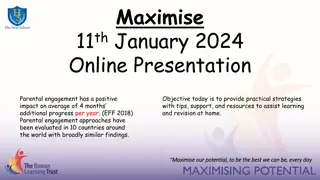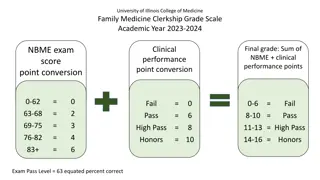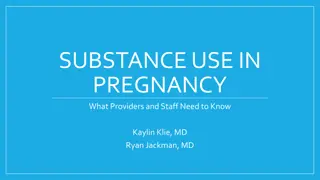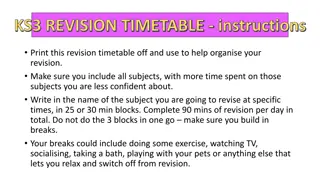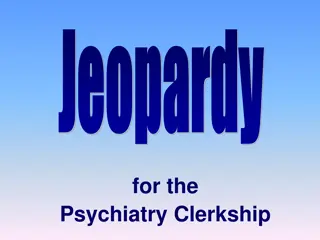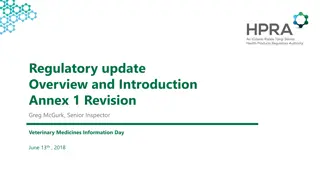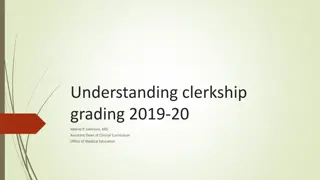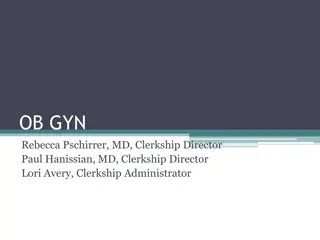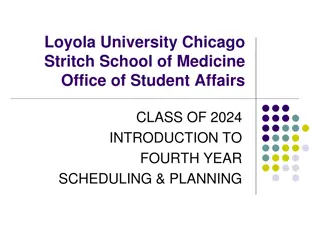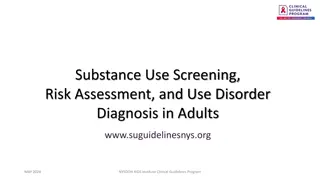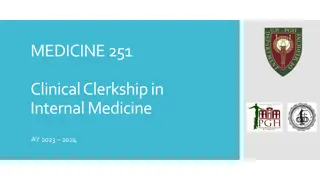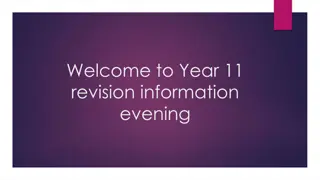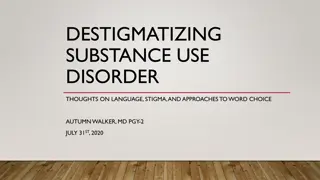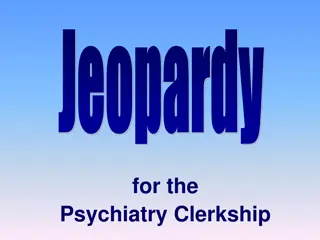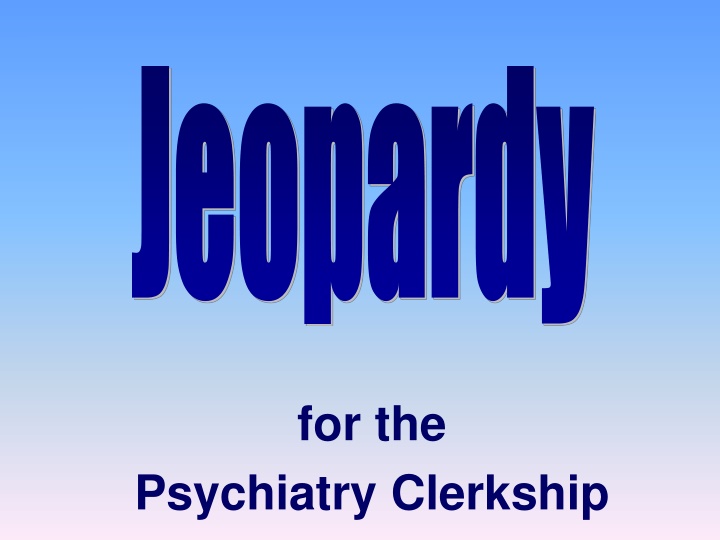
Psychiatry Clerkship Jeopardy Game: Substance Use Categories and Questions
Dive into the world of psychiatry with this interactive Jeopardy game focused on substance use. Test your knowledge on topics like DSM-5, alcohol use disorder, medication treatments, and more. Challenge yourself with questions on alcohol consumption limits, binge drinking criteria, and other important aspects of substance use disorders.
Download Presentation

Please find below an Image/Link to download the presentation.
The content on the website is provided AS IS for your information and personal use only. It may not be sold, licensed, or shared on other websites without obtaining consent from the author. If you encounter any issues during the download, it is possible that the publisher has removed the file from their server.
You are allowed to download the files provided on this website for personal or commercial use, subject to the condition that they are used lawfully. All files are the property of their respective owners.
The content on the website is provided AS IS for your information and personal use only. It may not be sold, licensed, or shared on other websites without obtaining consent from the author.
E N D
Presentation Transcript
Jeopardy Jeopardy for the Psychiatry Clerkship
And Now Here Is The Host . . . is proud to present Insert Name Here
The categories for todays Jeopardy on Substance Use will be:
Whos Counting?
DSM5 & Alcohol Use Disorder
Problems with Alcohol
Whos Counting? Med Tx DSM-5 Alcohol Use Disorder Alcohol LSC, PCP, XTC, Inhalants 100 100 100 100 100 200 200 200 200 200 300 300 300 300 300 400 400 400 400 400 500 500 500 500 500 600 600 600 600 600 700 700 700 700 700 800 800 800 800 800 900 900 900 900 900
What is 14 drinks per week? For healthy men < 65 y/o, risky use is considered to be more than this number of drinks per week Row 1, Col 1
What is 7 drinks per week? For healthy women < 65 y/o, risky use is considered to be more than this number of drinks per week 1,2
What is > 5 drinks in 2 hours? For healthy men < 65 y/o, a binge drinking episode is considered to be equal to or greater than this number of drinks in 2 hours 1,3
What is > 4 drinks in 2 hours ? For healthy women < 65 y/o, a binge drinking episode is considered to be equal to or greater than this number of drinks in 2 hours 1,4
What is 7 drinks per week? For any adult > 65 y/o, risky use is considered to be more than this number of drinks per week 1,5
What is > 4 drinks in 2 hours? For any adult > 65 y/o, a binge drinking episode is considered to be equal to or greater than this number of drinks in 2 hours 1,6
What is 4.5 (this) vs. 8.5 (that) vs 17 drinks (this-2)? The number of drinks per day if one consumes one-half pint of liquor is this vs. one pint of liquor is that vs. one fifth of liquor is this-2 1,7
What is 5? Number of drinks in a standard 750ml bottle of wine is this 1,8
What is 3.5 drinks (this) vs. 4.5 drinks (that)? The number of drinks in a 40 ounce bottle of beer is this vs. the number of drinks in a 40 ounce bottle of malt liquor is that? 1,9
What is 12 months? To diagnose an Alcohol Use Disorder, the symptoms need to be going on for at least this period of time 2,1
What is Social impairment? Impaired control Social impairment Risky use Pharmacological criteria Absence from work due to a hangover or going to work intoxicated refers to this Criteria A of Alcohol Use Disorder 2,2
1. What is Cut Down? (desire to cut down; unsuccessful attempts to decrease/stop use) 2. What is Impaired control? Impaired control Social impairment Risky use Pharmacological criteria In the CAGE screening, the C refers to this-1, which refers to this-2 Criteria A of Alcohol Use Disorder 2,3
What is this-1 tolerance? This-2 Pharmacological criteria Impaired control Social impairment Risky use Pharmacological criteria Needing markedly increased amount of alcohol to get desired effect; or decreased effect with same amount of alcohol is this-1; This-1 is this-2 of the above Criteria A 2,4
What is impaired control? Impaired control Social impairment Risky use Pharmacological criteria Binge drinking, which may be described as taking the substance in larger amounts or over a longer time period than intended, refers to this Criterion A 2,5
What is risky use? Impaired control Social impairment Risky use Pharmacological criteria Continued use in spite of blackouts, substance induced depression; Or driving a car, swimming, operating machinery while intoxicated refers to this Criteria A of Alcohol Use Disorder 2,6
1. What is annoyed? 2. What is Social Impairment? Impaired control Social impairment Risky use Pharmacological criteria In the CAGE screening, the A refers to this-1, such as recurrent conflicts with one s spouse or family about alcohol; The above refers to this-2 Criteria A of Alcohol Use Disorder 2,7
What is Risky use? Impaired control Social impairment Risky use Pharmacological criteria In spite of warnings about worsening and dire effects on their health from their physician, the patient still cannot stop drinking. This refers to this Criterion A 2,8
What is Impaired control? Impaired control Social impairment Risky use Pharmacological criteria Cravings: strong desire or urge to drink during which it is difficult to think of anything else; Refers to this Criterion A 2,9
What is GABA (this) and Glutamate (that)? Regarding the GABA/Glutamate system, alcohol intoxication results in more activity in this system and less activity in that system 3,1
What is Increase (this change) and Dopamine (that neurotransmitter)? While less than some other substances, alcohol leads to this change in the amount of that neurotransmitter in the ventral tegmental area -nucleus accumbens (VTA-NAc) 3,2
What is the starting alcohol level of the pt? The greater the level of intoxication, the longer it takes to sober up Half-life (t1/2) : 4-5 half-lives (t1/2) OR Pt starting EtOH level : constant detox rate to detox Alcohol metabolism is governed by zero order kinetics; thus the time from an intoxicated state to sobriety is depends on this 3,3
What is poor to none? For patients with Risky Alcohol Use or mild Alcohol Use Disorder, medication s treatment effectiveness is this 3,4
What is alcoholic hallucinosis? Hallucinations (visual > auditory) that develop within 12-24 hours of abstinence during which the patient retains insight are called this 3,5
What is assess severity of alcohol withdrawal? (CIWA = Clinical Institute Withdrawal Assessment) Regarding the treatment of Alcohol Use Disorder, CIWA is a standardized scale used to assess this and to guide the treatment of this 3,6
What is euphoria? A substance that increases dopamine in the ventral tegmental area-nucleus accumbens (VTA-NAc) faster than the homeostatic mechanism can keep up with will result in this 3,7
What is Glutamate (this) & GABA (that)? Regarding the GABA/Glutamate system, a seizure during alcohol withdrawal may result from increased activity in this system and decreased activity in that system 3,8
What is Kindling? Repeated episodes of alcohol withdrawal that increase the likelihood a patient will have severe alcohol withdrawal is an example of this; This is also why once a patient has gone thru Delirium Tremens (DT s), the pt is at a higher risk for future DT s 3,9
What is naltrexone (Revia)? (Vivitrol, not Revia, is the trade name of the injectable form of naltrexone) This medication is used to treat moderate-to-severe alcohol use disorder and is available in a monthly depot injection 4,1
What is acamprosate (campral)? This medication is safe to use for treating patients with moderate-to-severe alcohol use disorder who have liver disease, but it is contraindicated if the patient has severe renal disease 4,2
What is none? (combination therapy not shown to be more effective than monotherapy; evidence is mixed at best) Use of these two medications in combination is more effective than a monotherapy approach in the treatment of moderate-to-severe alcohol use disorder 4,3
What isnone? Compliance with this medication has been shown to help patients who are risky users of alcohol (heavy drinkers, at risk use, hazardous use) or have a diagnosis of mild alcohol use disorder 4,4
What are disulfiram (antabuse)? Upon consuming alcohol, this medication inhibits aldehyde dehydrogenase which leads to a build up of acetaldehyde and negative reinforcement of alcohol use 4,5
What is naltrexone (Revia)? Blockade of the mu-opioid receptor is the mechanism of action for this medication that is used to treat patients with moderate-to-severe alcohol use disorder 4,6
What are acamprosate (campral)? Proposed mechanism of action is that this medication acts as a glutamate neurotransmission modulator which leads to a reduced return to drinking and an increased cumulative duration of abstinence from alcohol 4,7
What is disulfiram (Anatabuse)? Studies indicate that for this medication to be most effective in treating moderate-to- severe alcohol use disorder, it should be taken under supervised conditions 4,8
What is naltrexone (Revia)? While this medication cannot be started if the patient is using opioids, it can be started while the patient is still drinking alcohol 4,9
What is Risky Use/At Risk Use? >7 drinks/wk (women); 14 drinks/wk (men) The BI (Brief Intervention) of SBIRT appropriate and often effective for patients < 65 y/o who drink this many drinks per week 5,1
What is Alcohol Use Disorder-mild? While controversial, research suggests patients with this severity level of Alcohol Use Disorder may pursue a harm reduction approach and resume normal or controlled drinking 5,2
What are elevated GGT? While elevated liver enzymes (AST/ALT) may indicate problematic alcohol consumption, at least 70% of individuals who have an elevated result of this lab test are persistent heavy drinkers (8+ drinks/daily or 50+ drinks per week) 5,3
What are Two? Of the 8 symptoms in the diagnostic criteria: Autonomic Hyperactivity; Tonic-Clonic Seizures; Psychomotor Agitation; Anxiety; Insomnia; Tremor; Transient Hallucinations/Illusions; Nausea/Vomiting There need to be this many to diagnose Alcohol Withdrawal 5,4
What are 3-4 times? For an individual who has a close relative (parent) with an alcohol use disorder, their risk is this many times higher than normal 5,5


